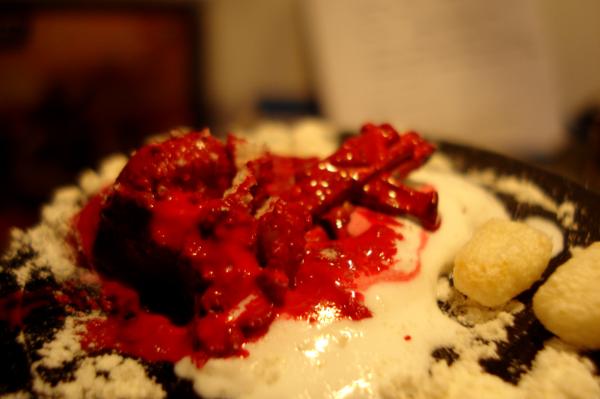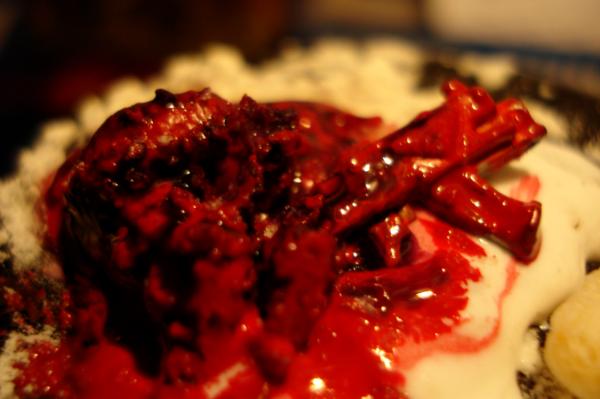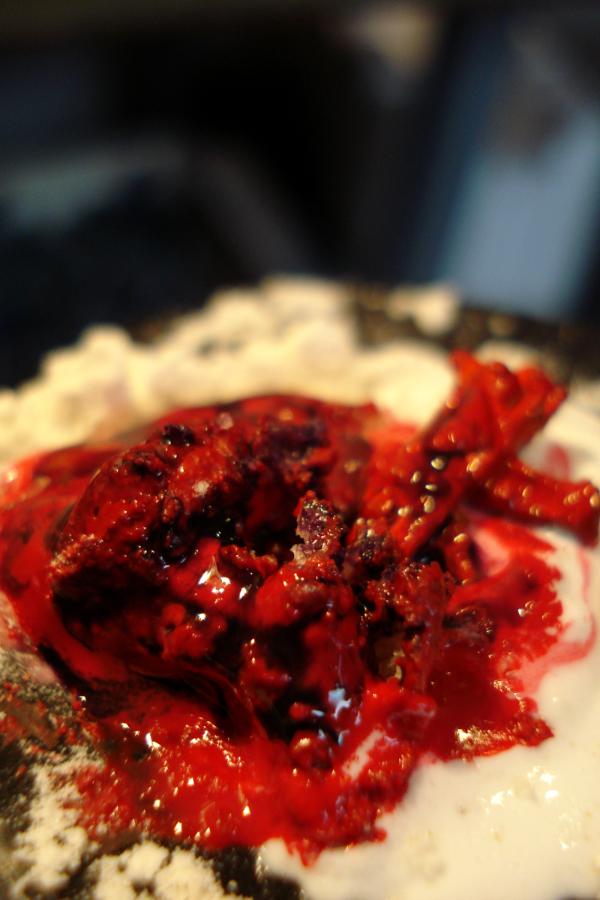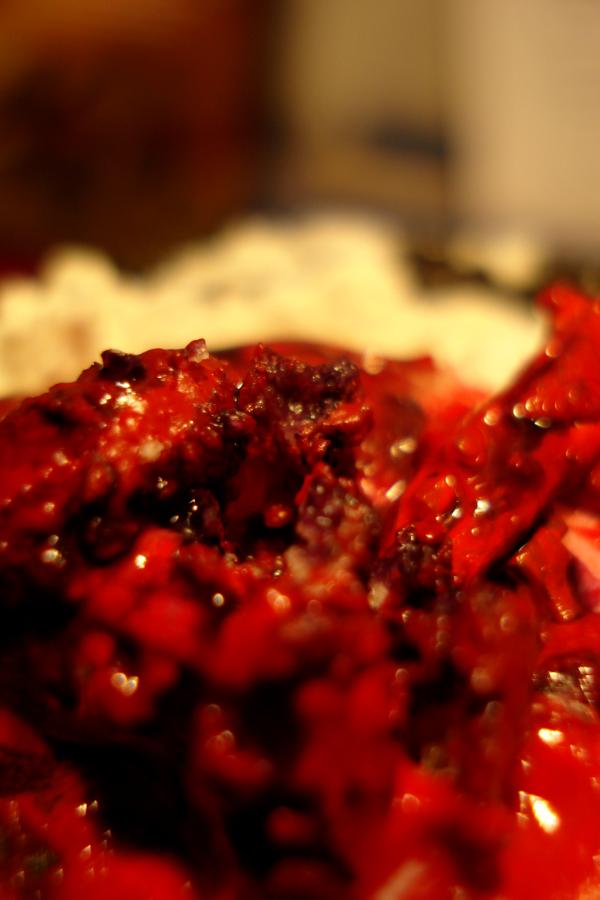Next, I blu-tacked the tiles onto sheets of cardboard. Note I only have a dozen or so tiles on each sheet. This is because this was the test run to check the colours ad techniques all worked and looked good. But you save more time the more tiles you stick up each time, so I'll be doing twice as many tiles at a time in future.
Its important to keep the vertical sections all aligned the same way. So the top of every wall is at the top of the card sheet, the bottom of every wall is at the sheet's bottom. It doesn't matter which way you line up the floor tiles.
Once the sheet is full, I took them out to the garden and primed them black. Most of the time I tell people it really doesn't matter what colour primer you use. But here, its important to use black. Any black - GW, Army Painter (which I use), or Halfords. But Black.
 |
| Check those corners |
When the primer is dry, I sprayed the tiles with Humbrol Acrylic Sea Grey. This is a dark grey, almost black.
 |
| A slightly uneven paint job will give your tiles 'character' |
A smooth finish is not vital here - you can afford to be a little patchy. This may be counter-intuitive. You're always told that you need to get smooth layers of paint on models. But this is large scale terrain and a little variation in tone and texture is normal and natural and will make your tiles look better and more realistic when you're all done. I'm not saying leave parts of the tiles blank or to skimp on the paint. Just that you don't need to plaster the plastic trying to make every square millimeter of the thing a flat matte uniform shade.
I also spray the paint down onto the tiles. I don't mean just holding the can above the tiles, but firing it from the direction that is at the 'top' of each tile. This is most easily done by holding the sheet of card with my hand at the top of the sheet, and then spraying away. What this does is put a bit less paint on the bottom of any raised surfaces on the tiles. Doing it this way you get a 'drop-shadow' effect. It means you have shaded the tile without even trying and this is why you needed to make sure all the tiles were lined up the same way and primed with black paint. Again, this effect will be helped by not blasting every tile with paint until it squeals for air.
Note: this effect is probably easier to achieve with an airbrush than a spray can. But speed is more important right now.
So now we have a sheet or sheets of tiles, all primed, and all base-coated. Now its time to apply the main colour.
At this point I switch to the airbrush.
I would guess that at least one person reading this now is thinking'airbrushes are expensive' or 'airbrushes are for expert painters' or something like that. Let me assure you, neither of those statements are correct.
My airbrush is really basic. It was a cheapo ebay purchase - £75, I think, for two (!) brushes and a compressor. For that I got a half-decent compressor and two basic airbrushes. It literally pumps air through the brushes and forces paint to go along too and thats it. No fancy gizmos, no variable apertures or trigger resistances. It is one step up from what I would recommend anyone unable to get what I did - a GW spraygun. I think these are around £15 now and you'll need a can of compressed air too. Either of these systems will do for this, giving you the ability to spray much finer layers than a can and much smoother, more even layers than a brush.
Now its time to talk about the coolest part of the process - salt masking. Salt masking is using chunks of salt to mask areas of your model so they don't get any paint on them in the next layer. Its a fantastic technique to simulate wear and tear on painted surfaces. There are other ways to do it but salt-masking is the coolest. It looks like cookery but feels like magic when you do it right.
You will need:
- salt, proper rocky or crystallised salt, the sort that goes in a grinder, not table salt. I use Waitrose Coarse Sea Salt Crystals.
- hairspray. Get the cheapest stuff you can find. I use Tesco Value.
 | |
| Ready salted. |
When it is, load up your airbrush or spray gun with the main colour for the tile. I used Vallejo Model Air Pale Grey Blue as it seemed like a nice match to the Deadzone mats.
In theory Model Air paints don't need any diluting. In practice I found the Grey to be a little thick, so I did cut it with a tiny bit of Tamiya Thinners. You want a fairly even coat here, but as with the previous step, a little patchiness is quite acceptable. Take note, some of the salt will probably fall off here, so make sure you're painting on a surface you can collect it from easily afterwards. As with the base coat, spray the wall tiles from their top side to accentuate that drop shadow effect.
Once this layer has dried, you will need a pot of warm or hot water and some cotton wool. Dip the wool in the water and use it to wipe off the salt crystals from the tiles. Now check out that magic! Say to yourself, 'Boy, can I paint!'. It doesn't matter if you scratch the paint as you go, or find slightly thicker areas where the light grey paint peels or rubs off. The more damage you do to it the better really.
 |
| Boy, can I take photo's. |
But all that grey can be a bit overpowering though and make a table look a bit washed out. Don't get me wrong - a collection of salt masked tiles put together will make some impressive looking scenery people will love playing on. But for a little extra 'pop' I added some accent colour and used the salt mask technique again.
For my first batch of tiles I chose Vallejo's Game Colour Gold Yellow. At first glance this seems like a really strong colour. But you have to bear in mind the cold/hot colour model. That is, if you use lots of 'cold' colours - greys, some blues, some greens, - you can accent it with a contrasting 'hot' colour. In this case I have cold greys everywhere, so I am contrasting it with the warm yellow. Reds would also work, and probably some browns and purples as these also have red pigments in them.
I used Tamiya's masking tape to protect most of the tiles, then salt-masked the tiles as above before airbrushing on the yellow. Here's how they look when I wash off the salt.
You don't need to do this accent step to every single tile. I did it to every one of the first batch just so I wouldn't need to do it again. If you did do it to every tile, well, you'd lose a bit of that individuality and leave your table looking all uniform again. I'll probably do a few more of the barricade tiles, just because it seems to make narrative sense these things would be painted to stand out a bit. But not every single wall and every single door needs to be marked out the same.
Note I only did this on the vertical tiles too. For the floors I did a quick wash with GW's Steel Legion Drab and dabbed it all over the tiles. Steel Legion is great for a generic 'dusty' look and here's how the dried tiles look.
Its probably a good idea to give the tiles a coat of varnish at this point and I used Army Painter's Matt Varnish. These things are going to get a lot of wear and tear as they get put together, played on, and taken apart again.
The next step should be obvious: take the tiles off the board, turn them round, and do it all again to the other side. I might not even bother doing the floor tiles again though. One side is all you're ever likely to really see and that's done.
Take care when spraying paint on this second side though. Don't forget you have already painted the first side and you don't want paint creeping under the tile and ruining your paint job. A little stray paint won't hurt, just don't spray the tiles from extreme angles.
The most time consuming part of this whole process then is tacking the tiles onto the cardboard. Spraying the first two coats takes maybe five minutes. Spraying on hairspray and sprinkling on salt takes a bit longer, particularly as you have to wait for the hairspray to dry. Masking up areas for the accent colours is a little time consuming. But if you do a big enough sheet of tiles you only need to do it once. Get big tape. All in all, it is quite possible to paint scores of tiles, on at least one side, in an afternoon.
edit:for those put off by airbrushing or salt masking go here for a guide to similar technique that uses neither.
Hopefully then, this guide has been useful to someone and I'm always open to questions or ideas for other ways to do things so feel free to leave a comment and, if you liked the guide, please click on the ad at the top right :)






